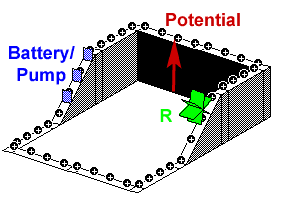I'm trying to elaborate a simple explanation (and conceptually correct) of how a battery charges and discharges, and why we say things like "the charge stored in the battery is x Ah". For now, I have this:
A battery stores potential chemical energy (potential energy because it is not being used, but can be used to do work), which can be converted into electrical energy by chemical reactions that occur inside it. This conversion happens when it is connected to a circuit.
Battery charging: For electrons to move from the positive terminal to the negative terminal of the battery, work must be done by an external source. This work, which is done on the electric charges that are on the positive terminal, results in accumulation of potential chemical energy in the battery, since it causes the reversal of the chemical reactions that release energy.
So , a battery does not store charge but rather energy. Despite this, in practice in many situations it is more important to know how much the battery will last and not how much energy it stores. So, although conceptually wrong, it is habitual to say "This battery stores a charge of x Ah" to indicate for how long a fixed voltage battery will be able to deliver a given current.
- So, is this little fragment I've written completely correct? Is it possible to improve it without giving up simplicity and conciseness?
In addition, some sources claim that a battery stores electrical potential energy. If this is true then my statement "This conversion [chemical -> electrical] happens when it is connected to a circuit" will be wrong.
-
I have a question about this: does a battery have voltage when it is not being measured? In other words, does a battery maintain an electrical potential difference even when it is not being used?
-
If so, does it mean that the battery converts potential chemical energy into electrical energy all the time and intensifies this conversion when used?
1st improvement (WARNING: This text still contains conceptual errors)
A battery stores charges (electrons), that stay bonded in the chemical compounds that form on the surface of its electrodes. Because of this, we also can say that the battery stores potential chemical energy (potential energy because it is not being used, but can be used to do work and chemical because this energy is stored in chemical compounds). Considering the fact that this potential energy is due to electrons, we can also say that a battery stores potential electrical energy. (Both measured in joules).
Due to the different amounts of bounded electrons in the electrode's chemical compounds, one electrode stays with excess of electrons, wile the other stays with depletion of electrons. Then, we call the first negative terminal and the last positive terminal. Having this in mind, we can say that the battery have a potential difference between its terminals. While we normally measure a difference of energy in joules, when dealing whit charges there's a more useful mesure: difference of energy (J) divided by amount of charge (C). This is called voltage or electrical potential difference or electrochemical potential difference.
Battery discharging:
When the battery is connected to a circuit, it starts the process of discharging. In this process, the electrical/chemical potential energy is released by the chemical reactions. In other words, the electrons bounded in the chemical compounds start to unbound and move around the circuit, until they reach the positive terminal. We have here the conversion of the potential electrical/chemical energy into electrical energy. This process lasts as long as there is a potential difference between the battery terminals.
Battery charging:
For electrons to move from the positive terminal to the negative terminal of the battery, work must be done by an external source. This work, which is done on the electric charges that are on the positive terminal, results in accumulation of potential electrical/chemical energy (and, consequently, accumulation of charge) in the battery, since it causes the reversal of the chemical reactions that release electrons. In other words, the electrons in the battery get bounded into new chemical compounds that form on the surface of electrodes due to external work. This process lasts until the voltage of the battery is lower than the applied charging.
The Ampere-hour unit:
One could say things like "This battery stores x J of energy", but in practice in most of the situations it's more important to know how much the battery will last, and not how much energy it stores. So, it's more habitual to say "This battery stores a charge of y Ah, because this indicates for how long a fixed voltage battery will be able to deliver a given current.
- So, are those explanations conceptually correct now?
- Does not the Charge Conservation Principle requires that the amount of charges entering in one terminal should be equal to the amount of charges coming out of the other terminal? If so, how can charges be stored in the battery when it is charging? What am I misunderstanding here?

Best Answer
There is no fundamental physical distinction on how electrochemical energy storage (EES) systems manage the charge-discharge process, in terms of "charges". Here is a review article that explains the entire spectrum of EES, from ordinary capacitors (they store energy in plain electrical field between two separated metal electrodes), to double-layer (aka "super-capacitors"), to "pseudo-capacitors", ending in rechargeable batteries, which accumulate charges by bonding electrons-protons into chemical compounds, and back.
Here is an illustration on nearly-continuous spectrum of possible constructions that use somewhat different methods to store "electron-proton" charge differences:
It might be difficult to simplify this fairly advanced field of engineering and studies into "batteries-for-dummies" terms.